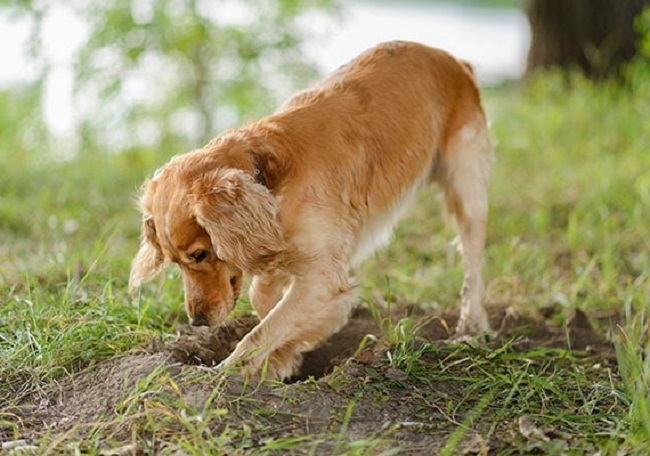
During the summer months, I receive a high volume of phone calls and emails from clients whose dogs are digging machines to rival a backhoe. One Rat Terrier demonstrated his true calling as “Indiana Bones” and excavated rocks from several feet below the surface. A Siberian Husky had practically prepared his owner’s yard for an in-ground pool and unearthed some antique pottery in the process. Too bad he couldn’t get a job with an archeological team.
Despite my clients’ awe at their doggies’ digging talents, they unanimously yearned for their backyards to be hole-free. If your yard has also transformed into your dog’s abstract dog-pile canvas my tips below should help. So take a deep breath and bury those frustrations (pun intended!).
Understanding Doggie Digging
There are many reasons why dogs enjoy digging, but boredom is almost always a key factor. Dogs who are regularly exercised both mentally, as well as physically, are far less likely to dig.
Digging Categories
Does your dog fit the description?
Young Energetic Dogs
Some of the most enthusiast diggers I’ve come across have been young or adolescent dogs, under two years of age. If you have a young, energetic dog who is not having his daily exercise requirements met, do not be surprised or upset with him for finding the best outlet he can for his excess energy. If your dog is hyper and left alone with nothing but the yard at his disposal, he will dig.
Terriers
Terriers and some small hounds were bred to tunnel after vermin. These dogs are genetically predisposed to dig, dig, dig, and dig some more! Every time they hear a mole scurrying under the ground you can bet that every cell in their body will compel them to unearth it. People who want to own a terrier breed need to be savvy and do their research before purchasing an earth dog. It is unfair to become upset with a dog that is simply doing what he was bred to do. Terrier owners need to be proactive and provide their pets with exercise and other outlets for digging (see below).
Unneutered Males
All responsible pet owners should spay and neuter their dogs, and if you have an intact male and your backyard is full of holes, I’ll bet you’ll be quick to agree with me. Intact male dogs will dig like it’s nobody’s business if they think they can dig themselves free to find a “girlfriend”. So, take the stress off your dog, your lawn and yourself by having him fixed.
Dogs with Thick, Heavy Coats
Malamutes, Huskies, Chows, Pomeranians, and other thick-coated breeds will dig to no avail in effort to keep themselves cool in the warmer months. If you were wearing a fur coat on a 90-degree day, you would do the same thing. Dogs are not fools: The dirt is much cooler to lay in than the grass.
Digging Solutions
If you are ready to put an end to Indiana Bones excavations consider the following: Spay or neuter your dog; provide extra exercise; offer a surplus of toys and bones and rotate them to keep your dog busy; set up a small doggie pool (any shallow kiddie pool will do) so that your dog can keep cool; enroll in a fun agility or training class to keep your dog’s brain satisfied; keep your dog indoors when you cannot supervise him; be sure he has lots of shade; fill old holes with rocks to deter re-digs; and, finally, give your dog the ultimate proper outlet for his digging by creating a “Legal Digging Zone.”
The Legal Digging Zone
If your dog is a dig-a-holic and no amounts of exercise or supervision will curb his insatiable appetite for dirt, then you should consider creating a digging pit so that he has an appropriate outlet to satisfy his need to dig. A digging pit should be approximately 4’ x 4’ for a small dog and 8’ x 8’ for a large dog. You can frame the box shape with wood or rocks. Remove the existing soil and make a bed of stone to supply good drainage in case of rain. Fill the rest with sand, replacing it every so often. You must teach your dog to love his own personal pit by burying toys, bones, pig ears, tennis balls, and other exciting treasures beneath the sand. You should make some treasures easy to find and others more difficult. Hide new goodies and toss old ones about once a week. Your dog will quickly find digging in his own pit far more rewarding than other areas of the yard, plus his inherent need to dig will be satisfied.
An Indiana Bones should not be left unattended in the yard while you are training him to use his personal pit. If you catch him digging, immediately interrupt him and redirect his digging to his own pit. Reward your dog for digging in his own designated area. Never punish your dog for digging. Remember that excessive digging is a sign of a much larger problem. As always keep your training session short, end on a success and have fun.
Tara Baggerman is the Trainer & Owner of Caliber Canines Positive Dog Training
Related Articles & Free Email Newsletter Sign Up
6 Hot Weather Safety Tips for Dogs
Irish Setters are Known for Their Enthusiastic and Affectionate Nature


Comment here